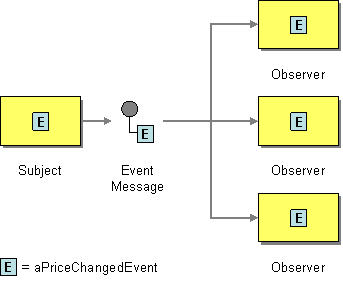Event Message
Camel supports the Event Message from the EIP patterns.
How can messaging be used to transmit events from one application to another?

Use an Event Message for reliable, asynchronous event notification between applications.
Camel supports Event Message by the Exchange Pattern
on a Message which can be set to InOnly to indicate
a oneway event message. Camel Components then
implement this pattern using the underlying transport or protocols.
The default behaviour of many Components is InOnly
such as for JMS, File or
SEDA.
Some components support both InOnly and InOut and act accordingly. For example the JMS
can send messages as one-way (InOnly) or use request/reply messaging (InOut).
| See the related Request Reply message. |
Using endpoint URI
If you are using a component which defaults to InOut you can override
the Exchange Pattern for a consumer endpoint using
the pattern property.
foo:bar?exchangePattern=InOnly
This is only possible on endpoints used by consumers (i.e. in <from>).
|
In the example below the message will be forced as an event message as the consumer
is in InOnly mode.
from("mq:someQueue?exchangePattern=InOnly")
.to("activemq:queue:one-way");And with XML:
<route>
<from uri="mq:someQueue?exchangePattern=InOnly"/>
<to uri="activemq:queue:one-way"/>
</route>Using setExchangePattern EIP
You can specify the
Exchange Pattern using setExchangePattern in the DSL.
from("mq:someQueue")
.setExchangePattern(ExchangePattern.InOnly)
.to("activemq:queue:one-way");And with XML:
<route>
<from uri="mq:someQueue"/>
<setExchangePattern pattern="InOnly"/>
<to uri="activemq:queue:one-way"/>
</route>When using setExchangePattern then the Exchange Pattern
on the Exchange is changed from this point onwards in the route.
This means you can change the pattern back again at a later point:
from("mq:someQueue")
.setExchangePattern(ExchangePattern.InOnly)
.to("activemq:queue:one-way");
.setExchangePattern(ExchangePattern.InOut)
.to("activemq:queue:in-and-out")
.log("InOut MEP received ${body}")
Using setExchangePattern to change the Exchange Pattern
is often only used in special use-cases where you must
force to be using either InOnly or InOut mode when using components that support both modes (such as messaging components like ActiveMQ, JMS, RabbitMQ etc.)
|
JMS component and InOnly vs InOut
When consuming messages from JMS a Request Reply is
indicated by the presence of the JMSReplyTo header. This means the JMS component automatic
detects whether to use InOnly or InOut in the consumer.
Likewise, the JMS producer will check the current Exchange Pattern
on the Exchange to know whether to use InOnly or InOut mode (i.e. one-way vs request/reply messaging)